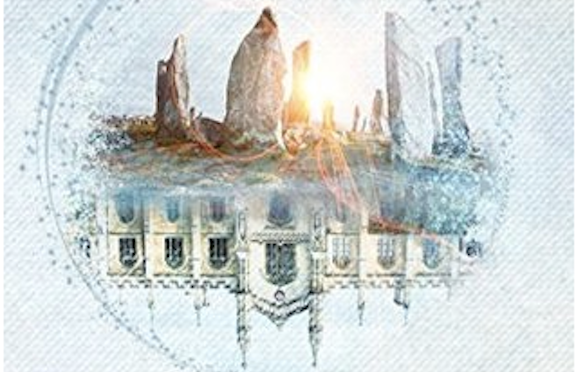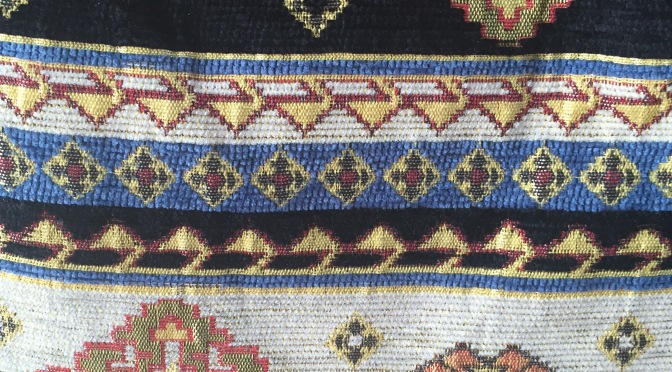One of my kids had this drink at an excellent restaurant near the great wall. Continue reading Mundane Monday: Chinese Coke
Monthly Archives: July 2017
Afghan Girls Orchestra, for #WATWB
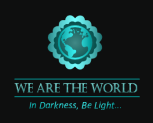 It’s time for this month’s We are the World Blogfest (#WATWB)! In a world where news and social media are awash with negativity, we aim to turn the focus on to small but significant stories that renew our faith in humanity.
It’s time for this month’s We are the World Blogfest (#WATWB)! In a world where news and social media are awash with negativity, we aim to turn the focus on to small but significant stories that renew our faith in humanity.
My article for this month is about Zohra, an all-female orchestra from Afghanistan. Named for a Persian music goddess, the orchestra toured the world earlier in the year, starting at the World Economic Forum in Davos, Switzerland. The musicians are all very young, most not out of their teens. And many of them are the first in their families, or even in their entire provinces, to play an instrument.
I was touched especially by the story of the 18-year-old conductor, who played the viola when she was an instrumentalist. Her uncle was initially against her playing in the orchestra, but he eventually grew to be proud of her.
“I’m happy that at least I changed my family,” she said, adding, her fellow musicians, too, “are going to change their families and when their families are going to change, you can have a society which is changed.”
Sign up to join us and be visited on the last weekend of the month when you post your article. Click here to enter your link on this Linky Tools list! This month’s #WATWB co-hosts are: Simon Falk, Roshan Radhakrishnan, Inderpreet Uppal, Sylvia Stein, and Damyanti Biswas. Please stop by and say hello!
Mundane Monday: Bicycles in Beijing
When I learned about China in school, I developed a mental picture of crowds of mostly identically dressed people riding bicycles in the streets. Continue reading Mundane Monday: Bicycles in Beijing
Book Review: The Time Table by Caroline Mather
 The Time Table by Caroline Mather
The Time Table by Caroline Mather
My rating: 4 of 5 stars
I received this independently published book to review as a member of the Book Review Directory, where my blog is listed. The writing style is fluid and a little formal, which fits the setting, and the formatting is clean and error free. I read it in about an hour on a plane, and it made the flight time pass quickly.
The Time Table is about a billiard table, built from slate cut from a Standing Stone in the British Isles, which serves as a portal through which people can travel through time. The author spends just the right amount of time and effort on explaining how this works—that is, not much—and gets right to the stories, which are all set in attractive periods of English history, including the present day.
The book works well as a collection of loosely-related tales centered around the billiard table and the London house where it has been located since the early 1700s. Quite a few people end up going through the table—so many that one is a bit surprised that it’s still a secret in 2016.
Overall the pacing of the stories is pretty good, never draggy, but sometimes the kissing starts surprisingly quickly and without much warning. There is a lot of kissing, caressing, and stolen, smoldery looks, but nothing more. The sexism of past ages is invariably dealt with or mitigated by the love of good men, and the table itself is always a force for good, helping its hapless humans work through their modern and not-so-modern dissatisfactions. The author’s optimism about love, relationships, the power of conversation, and the possibility of living happily ever after, is refreshing.
I don’t usually read time travel romances, so others more familiar with the genre might be less forgiving of some of this book’s foibles than I, but I found it to be a delightful break from heavier reading fare, like a tasty chocolate bon bon.
Thursday Doors: Hutong

Before our trip to Asia, I read Paul French’s Midnight in Peking, about the unsolved murder of a young British woman in prewar Peking. Much of the shadier action in that book takes place in the city’s hutongs, a type of narrow street or alley commonly associated with northern Chinese cities, especially Beijing.
Our first afternoon in Beijing my husband got an alert about an “FTF” (first to find) opportunity. A new geocache had been published in the city, but not found yet. Geocaches are relatively rare in China in the first place, and this author makes the point that you are trying to find those few caches amidst a billion muggles.
Another problem with geocaching in China is the “great firewall.” Google maps, Apple maps, and the geocaching apps that are based on them, do not work there. If you try to use one of these internet maps, it has an offset. For example, my app, Cachly, showed the cache almost 0.3 miles from its true location.

Fortunately, when the subject is geocaching, my husband is prepared. Before we left he did some research, and found that OpenStreetMaps, with user-created data, would still work in China. See this discussion thread for more details about the problems with using online maps in China. No matter what map we were using, however, we were directed around the main train station, and that meant hutongs! We set off. This would be a feather in our cap: two Anglos from California get an FTF in Beijing!
The first doors as we approached the station did look a little sketchy. The air wasn’t too bad, we could see blue sky, but the weather was still very hot and dusty. Many people were riding scooters and they could be seen parked outside.
People were friendly and one tried to help but didn’t speak English. They seemed bemused more than anything else by foreigners wandering around outside the station looking at their phones. They were less amused when we tried to buy water with a 100-Yuan note. And I don’t think we wanted to see what this public bathroom looked like on the inside.

As we went on, we started to see more welcoming storefronts and doors.
Eventually, all our water already gone, we did get to the park where the cache was to be found. More doors next week!
This post is for Norm 2.0’s Thursday Doors, a weekly feature allowing door lovers to come together to admire and share their favorite door photos from around the world. I’ll be sharing doors from my recent trip to East Asia for the next several Thursdays.
Mundane Monday: Walking Shoes
You hear a lot about shoes when you’re traveling, and it’s complicated figuring out which shoes to take. Shoes may be your heaviest item and make up the majority of the weight in your suitcase. And ill-fitting shoes can ruin your whole trip.
When travel shopping, I looked for some walking shoes that were also easy to slip on and off and not too heavy. I found these, and some Clark’s sandals. I wore them around the house for a day or two before we left.

They were pretty comfortable walking around Seoul for the first ~10,000 steps in a day. After that, my legs started to hurt. It wasn’t my feet that hurt but my joints, especially my knees. Surprisingly, for more than 15,000 steps, I was better off with the sandals, which were nicely cushioned but had more room and less arch support. This is probably because my feet swelled. Our hotel in Tokyo actually had an electronic foot and calf massager, which I used almost every night.

When I got back, Facebook showed me last year’s picture that I took of my feet, near Munich at the Starnberger See. While I enjoy moderate walking, I have to say that this is more my kind of vacation:
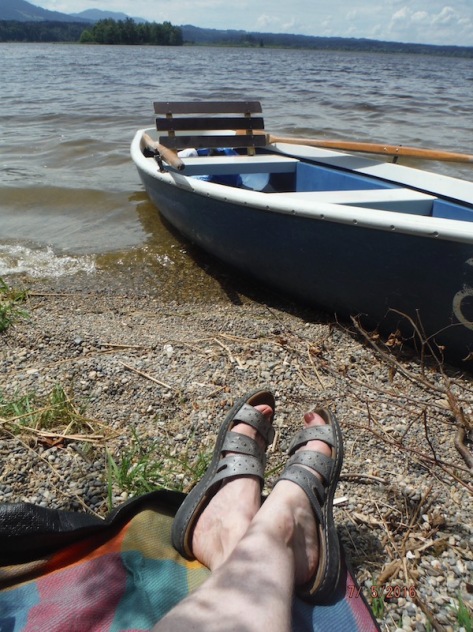
For the Mundane Monday Challenge #118.
Sweetening the Agenda
 The Erenwine Agenda by Maia Kumari Gilman
The Erenwine Agenda by Maia Kumari Gilman
My rating: 3 of 5 stars
The Erenwine Agenda is an ambitious eco-fiction romance which wraps a complicated and often contentious topic into an appealing package. The book tells the story of the romance between Amalia Erenwine, an intern at an architectural firm, and Mark Stone, a geologist who works for an energy company that Amalia’s firm is designing a building for. Amalia and Mark express different points of view about fracking and energy policy, and their political differences play out against the backdrop of the 2012 US Presidential election and Hurricane Sandy in New York City. I found it an enjoyable read, even though I wasn’t fully convinced by the author’s environmental or romantic agendas.
The author handled the subjects of fracking and green energy generally in a sensitive manner that didn’t devolve into boredom or preachiness. I especially liked the scene at the church for its characterizations and its presentation of diverse points of view. And I loved her point at the end: that the best solutions to a problem often come indirectly, when you stop pushing for them. The novel provided a blueprint for how people of goodwill can work through tough disagreements and preserve relationships. While this novel takes place in 2012, the contentiousness of the 2016 election makes the message of continuing to talk to each other and look for solutions across the political divide more relevant than ever.
I am only an occasional reader of romance, but as I understand it, the genre has certain conventions that were not evident in this story. Amalia and Mark were both young, hip, nice people, and moderately complex characters, but the story lacked romantic chemistry and sexual tension. Their disagreements with each other at the church discussion came across as off-putting and not particularly intriguing, overshadowed by the more interesting stories told by the other participants. And there were none of the traditional obstacles that keep star-crossed lovers apart—no misunderstandings, dark secrets, or jealous lovers–not even the promise of riches or a change in social station. As a result, it wasn’t important enough to me that these two characters get together at the end for the romance to be able to drive the plot.
In general the pacing was a little off, and the whole book was talky and overly long. It opened with . . . a meeting. Some tension was building for a while as Hurricane Sandy bore down on the city, but the storm’s consequences for our hero and heroine were completely benign. I needed to know more about how the characters were feeling about their situation at different points. They needed to be in some danger–physical, emotional, or psychological–but I never felt that urgency or intensity.
I’m also ambivalent about the title. It grew on me as I read the book and came to understand what Amalia’s agenda was and how it evolved. But it didn’t grab me from the start, and it first led me to expect Amalia to be some kind of Jason Bourne-like figure, a la “The Bourne Identity,” but she wasn’t. And naming your geologist Mark Stone . . . Really?
These quibbles aren’t enough to keep me from recommending The Erenwine Agenda as an antidote to the venom in our current political discourse and a way to learn about how communities respond to changing energy needs.
Thursday Doors: Downtown Seoul
Many buildings in Seoul are big, and serious. And the doors themselves are nothing special but there is a lot around them. An example of this is the War Memorial of Korea, commemorating the Korean War and those who died fighting it. A long stone staircase leads up to a wide mouth of windows.
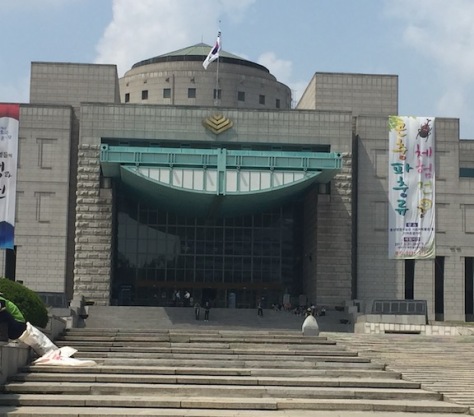
In downtown Seoul there are other examples, including the Metropolitan Library
And the Seoul City Hall in Seoul Plaza.
Gyeongbokgung Palace, next to Gwanghwamun Square, is more urban than Changdeokgung, which I blogged about last week. It stands close to other places of business in the city. On our last day, we walked past the library and City Hall and across Gwanghwamun Square to get to this palace.

Some doors of Gyeongbokgung:
Even in the middle of the city, there was a part of the palace that was an oasis from the rest.

This post is for Norm 2.0’s Thursday Doors, a weekly feature allowing door lovers to come together to admire and share their favorite door photos from around the world. I’ll be sharing doors from my recent trip to East Asia for the next several Thursdays.
Mundane Monday: Travel Bag
 This textile pattern looks like it could have come from one of the museums I’ve visited on my trip.
This textile pattern looks like it could have come from one of the museums I’ve visited on my trip.
But it’s actually from the side of my travel bag. This bag is smaller than most backpacks, but big enough to hold passports, a water bottle, my journal and pen, various chargers, band-aids, anti-itch cream, a nail clipper, and has pockets so I don’t lose my subway card and hotel key card.
I bought the bag in Turkey about 8 years ago. I don’t know the origin of the pattern or if it’s “authentic.” I just liked the patterns and the colors. Like me, it’s pretty far from home.
For the Mundane Monday Challenge #117.
The Literature of our Time?
My rating: 3 of 5 stars
A Personal Review of American War by Omar El Akkad
I conceived of the original idea for my WIP in 2012. It is a science fiction novel with a young adult protagonist set in the year 2074, and I wrote an early draft during the 2012 NaNoWriMo. At the time of that election, maps of blue and red states divided into different “countries” with humorous labels were being widely distributed on social media.

I used to read these and laugh. I lived then, as now and for most of my life, comfortably in a big, wealthy, blue US state. And I didn’t take the whole idea of my country splitting up very seriously. The Federalized USA aspect of my novel was a thought experiment. In real life I believed that the Civil War, and the slave trade that spawned it, was ancient history, a tragedy and a disaster on a scale too horrific to contemplate ever happening again.
Now here I am in 2017, reading and reviewing a book about a second American Civil War. Others have reviewed it more generally and skillfully; this review will be simply a personal opinion, based on my own experiences and ideas.
My first reaction, upon finding out that this book existed was, “oh rats, I didn’t write fast enough.” Not only does it take place in the same time frame as mine, and depict the USA splitting apart, but some of the action takes place in Louisiana (as does mine), and it follows the fortunes of a teenage girl of mixed ethnicity whose father disappears and who is the main viewpoint character (as my novel does). North America is irrevocably changed due to the effects of fossil fuel overuse, climate change, the flooding of the coastal cities and creation of internal refugees (ideas that also play out in my novel). I picked up American War more out of a sense of duty—because if I’m going to write eco-science-fiction, I should know what’s out there and what’s been written on the topic—than out of real excitement. In the back of my mind, I thought, I should finish and publish my own book before it’s too late and *every* book is about this.
As of this writing, American War has gotten a lot of praise, much of it well-deserved. The world building and construction of future history is excellent. The author’s journalistic touch is evident in the immediacy of the storytelling. Like other groundbreaking works of art, this novel does not hew to a standard creative writing format of protagonist/antagonist/try-fail cycles. Its style will probably have wider appeal than most post-apocalyptic science fiction does; it will likely be read in blue-state book groups. The futuristic technology is not particularly interesting, well thought out, or essential to the narrative: the novel is not really science fiction; it’s not a hero’s journey; and it’s not even a tragedy in the literary sense.
My inability to classify it may be at the root of why I found it unsatisfying. Or there may be other reasons: unsympathetic characters, confusing plot points, a limited view of what human beings are capable of, a failure of vision. Or all of the above.
I didn’t like the character of Sarat Chestnut. A mere lack of likability wouldn’t be a problem in a novel, especially for an anti-hero. But for someone so important to this fictional world and the events described therein, Sarat was practically a cipher with no inner life to speak of. She was ostensibly a tween girl, then a teenager, and then a youngish woman made old before her time, but she read more like a man, and not only because she was 6’5”, bald, good at fist fights, and sexually attracted to girls.
I wanted to know what Sarat thought, and felt, about her parents before they were killed. Her relationships with Marcus and with Albert Gaines were more fully realized than any of her family relationships. Today’s burning issues of racism, sexism, trans- and homophobia, and religion itself, appear to play little to no role in Sarat’s ideology or motivation. I wanted to know what it was like to be genderqueer then, in the rotting remains of a society that had once recognized same-sex marriage and held celebratory pride parades. I wanted to know why she insisted that they schlep that statue of the Virgin of Guadalupe northward to the refugee camp. Did Sarat ever think about God, or an afterlife, or any big metaphysical questions, even if only to reject the easy answers?
Instead, all I got from Sarat, after she had everything brutally taken from her (but survived herself virtually unscathed), was her inexplicably destroying a bunch of her mentor’s books in his office. Even in the depths of the worst torture the Blues could throw at her, she was never really vulnerable. Where did that strength (or that sheer cussedness) come from? Nothing forged it, nothing fed it, nothing broke it; she simply seemed to have been born with it, and it carried her to her grave. The otherwise superfluous Yuffsy fight scene also seemed to be there to underscore this particular theme by showing Taylor, an old, broken fighter, simply continuing to fight his superior opponent, stubbornly and ineffectually, unto death.
There were other aspects of the book that I thought were just silly: the out-of-control drones, for example. In a real war there would have been much more redundancy built into the system; taking out one server farm wouldn’t have been enough to render the “birds” permanently deaf. More interesting was the implication of psychological warfare—hinted at but not stated outright—that the drones weren’t really deaf or out of the Blues’ control; they were just believed to be. And I could have done without the portentous omniscient 3rd-person narrator butting in at random times to tell me that the Chestnuts never really had to move North in the first place, or that Sarat would never see her brother again.
This is not to say that I thought all the characters were cardboard or the relationships unrealistic. I enjoyed the section told from Benjamin’s point of view the most of the entire book. His relationship with Sarat was genuine and touchingly portrayed, and it provided a bit of relief from the unrelenting darkness of the rest of the narrative. But the conceit that it was told from a 6-year-old’s point of view frayed quickly because he didn’t usually sound like a 6-year-old, and events and conversations were described at which 6-year-old Benjamin would not have been present.
The sentence that “you win the peace with stories,” was underlined in my Kindle version, suggesting that it resonated with a lot of readers. Its implication in context was that the Blues might have won the war by superior military firepower, but they were not winning the peace because they didn’t understand that truism about stories. I waited for that quote to be skillfully dramatized in the novel, and am still waiting. It’s not a spoiler to say that nobody won the peace in this book.
Like The Water Knife by Paolo Bacigalupi (which I reviewed here earlier this year), American War serves as a well-done cautionary tale of what could happen to the world if humanity does not change course. Such books may be proliferating in these times, and they reflect our deepest anxieties. But it is my opinion that stories like these can only go so far in helping us win the peace. We also need the optimism of Star Trek, the literature of empathy, characters with rich inner lives, and the faith to imagine something different.




